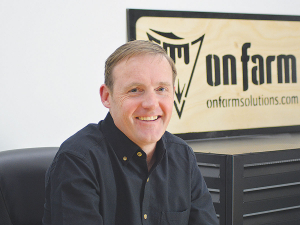Fieldays hold out the begging bowl
OPINION: When someone says “we don’t want a handout, we need a hand up” it usually means they have both palms out and they want your money.
 Automated teat-spraying has become far more commonplace in rotary dairy sheds, says Gary Arnott, founder and chief executive of Onfarm Solutions.
Automated teat-spraying has become far more commonplace in rotary dairy sheds, says Gary Arnott, founder and chief executive of Onfarm Solutions.
Canterbury based dairy tech firm Onfarm Solutions says it has developed an effective, consistent automated tear spraying system for herringbone dairy sheds.
"Automated teat-spraying has become far more commonplace in rotary dairy sheds, with much of that being our own technology," says Gary Arnott, founder and chief executive of Onfarm Solutions.
"However automated systems in herringbones have been very hit and miss affairs, with wasted and poorly targeted spraying. Our Teatwand Stepover System changes that."
Often existing herringbone teat spray systems would be set up just outside the dairy exit, exposed to wind and air movement that required significantly larger amounts of spray to compensate for lack of accuracy.
When Covid shut down an overseas project Onfarm Solutions engineers were working on, their attention refocused upon the yet to be cracked herringbone solution.
Advances in optical sensor technology and control systems enabled a design that can measure where and when a cow is passing through the exit lane post-milking, with the programme selecting the optimal spray sequence for the four nozzles in the system.
"The design has had to incorporate the usual challenges that go with dairy cows being large animals with a variety of body shapes, movement patterns and temperaments, and the system's response to their movement reflects this," says Arnott.
If the cow is moving slowly through the exit only two nozzles will activate for the spray sequence, and a faster pace will result in all four nozzles deployed for assurance of full teat coverage. Should the cow stop walking, the spray system sprays the teats once the cow walks through once only.
Arnott says the combination of sensor technology, smart programming and well-founded engineering principals that established the company's rotary teat spray systems have been encased in a robust hardware design, built to take the impact dairy herds can inflict on equipment.
This includes a solid stainless-steel casing that can take a cow’s full weight, with an inbuilt nozzle wash system to clear effluent from the sprayer’s nozzles for continuous clear spray flow.
The design was proven over the past dairy season on a North Canterbury dairy unit that provided in-field feedback for final design tweaks.
Onfarm Solutions engineers have been able to apply some of their learnings from the company’s highly successful Teatwand Exact automated spray system used in rotary dairies to the Stepover.
Over 1,200 of the Teatwand systems are now in use globally.
As in rotary platforms, teat spray has proven to be a hit and miss job in herringbones when done both manually and automatically, says Arnott.
A survey of manual teat spray practices done a decade ago found two out of every three farms were using the wrong dilution rate, and only one in three got good coverage of all four teats.
This is despite numerous studies that prove accurate teat spray will reduce new mastitis infection rates by 50%. Mastitis in turn is one of the main health issues in dairy herds, costing New Zealand dairy farmers about $180 million a year.
Arnott says the Teatwand Stepover is backed by the company’s extensive sales and service network. He’s highly encouraged by the number of forward orders received by his company as farmers consider their capital investment programmes for the coming dairy season.
Effective from 1 January 2026, there will be three new grower directors on the board of the Foundation for Arable Research (FAR).
The National Wild Goat Hunting Competition has removed 33,418 wild goats over the past three years.
New Zealand needs a new healthcare model to address rising rates of obesity in rural communities, with the current system leaving many patients unable to access effective treatment or long-term support, warn GPs.
Southland farmers are being urged to put safety first, following a spike in tip offs about risky handling of wind-damaged trees
Third-generation Ashburton dairy farmers TJ and Mark Stewart are no strangers to adapting and evolving.
When American retail giant Cosco came to audit Open Country Dairy’s new butter plant at the Waharoa site and give the green light to supply their American stores, they allowed themselves a week for the exercise.
President Donald Trump’s decision to impose tariffs on imports into the US is doing good things for global trade, according…
Seen a giant cheese roll rolling along Southland’s roads?